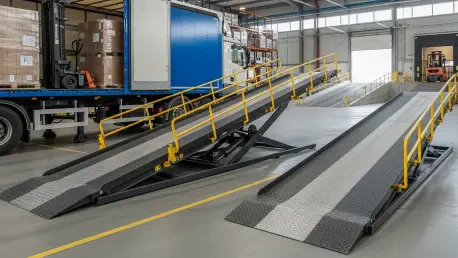In the fast-paced world of logistics, where every second counts and operational efficiency can make or break a business, finding innovative solutions to infrastructure challenges is paramount. Smith Brothers Stores (SBS), a prominent family-owned HVAC merchant in the UK, faced a significant hurdle at its sprawling 70,000 square foot distribution hub in Leicester. The facility, originally built for courier and freight sorting, lacked the necessary external loading capabilities to support a growing fleet of 26-ton vehicles. Without safe outdoor access for forklifts or secure indoor storage options, SBS needed a game-changing approach to maintain its rapid expansion. Instead of resorting to costly and time-intensive construction projects, the company turned to a tailored solution that not only addressed immediate needs but also set a new standard for adaptability in the logistics sector. This strategic move has captured attention across the industry for its ingenuity and effectiveness.
Tackling Infrastructure Challenges with Innovation
At the core of SBS’s operational dilemma was a facility design that didn’t align with the demands of a modern distribution hub. The Leicester site featured dock-level doors but offered no practical means for forklifts to load or unload vehicles outdoors, nor did it provide a safe way to store the fleet indoors overnight. Traditional solutions, such as constructing permanent loading bays, were deemed too disruptive and expensive, especially for a company in the midst of significant growth. SBS required an approach that could deliver immediate results without compromising long-term scalability. By prioritizing flexibility over fixed infrastructure, the company sought a way to bridge the gap between current limitations and future ambitions. This challenge underscored a broader trend in logistics: the need for adaptable solutions that can evolve with business demands while keeping costs in check. SBS’s response to this issue marked a pivotal shift in how logistical constraints could be addressed without breaking the bank.
The decision to explore custom equipment rather than structural overhauls led SBS to a transformative partnership. After evaluating multiple suppliers, the company identified a collaborator renowned for heavy-duty truck ramps and a commitment to tailored solutions. The chosen partner demonstrated not only technical expertise but also a willingness to engage deeply with SBS’s specific needs. This collaboration resulted in the design and installation of two bespoke ramps—a 3-meter and a 4-meter wide unit—that enabled safe forklift access for outdoor loading while allowing vehicles to be securely stored indoors. The project’s success hinged on meticulous planning, with detailed surveys and on-site discussions ensuring that ramp angles and clearances met exact operational requirements. This innovative setup provided SBS with a practical workaround that enhanced workflow efficiency and eliminated the need for costly construction, setting a precedent for similar challenges in the industry.
Building Trust Through Strategic Partnerships
A key factor in SBS’s logistical breakthrough was the emphasis on partnership and trust throughout the project. From the initial consultation to the final installation, the collaboration involved multiple stakeholders, including door specialists and vehicle manufacturers, to guarantee seamless integration of the custom ramps. The supplier’s distributor played an instrumental role in coordinating efforts, ensuring that every detail was accounted for during the implementation phase. John Hammond, the National Distribution Manager at SBS, praised the transparent communication and actionable insights provided by the team, which fostered confidence at every step. This level of cooperation was not just about delivering equipment but about crafting a solution that aligned perfectly with the company’s operational goals. The project highlighted how strong relationships between businesses can drive innovation, turning complex challenges into opportunities for improvement in logistics operations.
Beyond the immediate benefits, the partnership’s impact extended to long-term strategic planning for SBS. With the company’s remarkable growth—expanding from a handful of branches to over 20 in recent years—the ability to replicate such flexible solutions at other locations became a critical advantage. The custom ramp installation offered a scalable model that could be adapted to future sites without the burden of extensive infrastructure investments. This approach not only addressed the Leicester hub’s unique constraints but also positioned SBS to respond swiftly to evolving demands across its network. The collaboration demonstrated that trust and expertise are as vital as the equipment itself, creating a blueprint for how logistics firms can navigate growth challenges. By focusing on customized, cost-effective solutions, SBS and its partners showcased a forward-thinking mindset that prioritizes operational agility over traditional, rigid frameworks.
Reflecting on a Scalable Logistics Legacy
Looking back, the installation of custom truck ramps at SBS’s Leicester distribution center proved to be a defining moment in overcoming logistical barriers. The initiative delivered a safer working environment by facilitating efficient vehicle and forklift access, while also unlocking greater operational flexibility. This project stood as a testament to the power of innovative infrastructure solutions in transforming challenges into competitive advantages. The collaboration with trusted partners ensured that every aspect of the solution was tailored to meet specific needs, setting a high standard for problem-solving in the industry. As SBS continues to expand, the lessons learned from this endeavor—particularly the value of adaptability and strategic alliances—offered a roadmap for tackling future hurdles. The success of this project encouraged other logistics firms to consider flexible, equipment-based solutions over permanent construction, paving the way for more sustainable growth strategies in warehousing and distribution.









